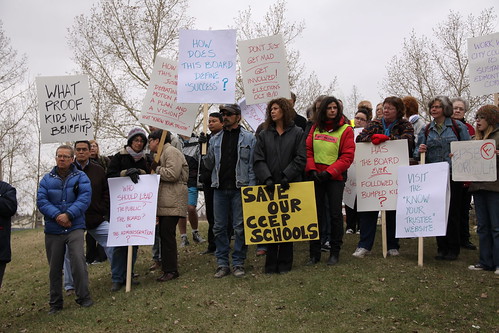
Last night, I attended the Edmonton Public School Board meeting where Trustees voted to close five Edmonton schools (Parkdale, McCauley, Eastwood, Capilano, and Fulton Place schools will close at the end of June 2010).
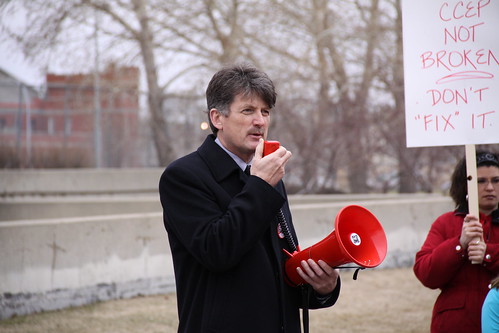
The meeting was preceded with a demonstration where over 200 parents and students rallied against the closures and welcomed community leaders, including MLAs Hugh MacDonald and Brian Mason, to speak to the crowd. After the demonstration, the crowd poured into the meeting hall (and thanks to the Edmonton Journal the meeting was live-streamed online so that people across the City could watch).
As the meeting began, it was clear that it would be a very tense evening. At one point during the meeting, as Trustee Sue Huff called out fellow Trustee Ken Shipka for not speaking to the motion to close one of the schools (Mr. Shipka would only say that he was voting for the closure), Board Chair Don Fleming snapped at Huff “RELAX!” It was an out of line comment from Trustee Fleming and only increased the thick intensity in the room.
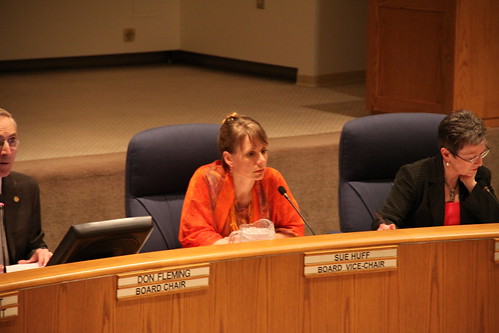
I shared some thoughts on the inner city school closures a couple of weeks ago and I continue to believe that many of the challenges facing inner city schools have been caused by the lack of smart urban planning in Edmonton. As Edmonton continues to sprawl and spawn new neighborhoods in each direction, it has become increasingly difficult for the school board to plan the future of its schools. This is an issue of urban planning and coordination between City Councillors and School Board Trustees that needs to be addressed. Both Councillors and Trustees are doing Edmontonians a disservice when they do not work together.
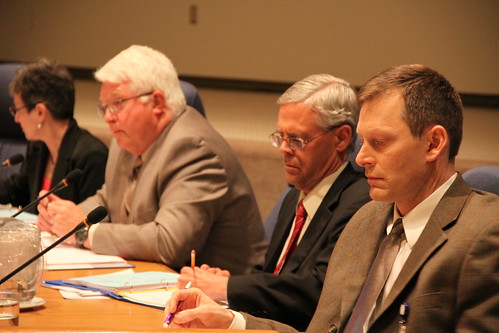
I also feel that the Public School Trustees could be more creative with how they use the space available in these undercapacity schools. Could renting out unused space to non-profit, community, or public health groups help cover the costs of keeping these schools operating at such low capacities? Maybe this would not save every school from closure, but it might allow consolidation of two into one. I got the district feeling at last night’s meeting that most Trustees may had not considered these kind of ideas. It is my observation that there are only three Trustees who have been willing to look out of the box since the last election (Trustees Huff, Dave Colburn, and Catherine Ripley have caught my attention).
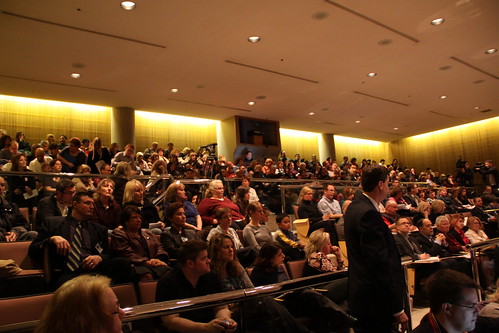
Last night the meeting room was packed with over 200 engaged and irritated citizens. Hopefully they will continue to stay engaged and challenge incumbent Trustees who continue to think inside the box when it comes to options for under-capacity schools. A growing number of these citizens have helped form groups like ARTES and understand that the election is only six months away.
Check out Flickr for more photos.
Read the Tweets from last night’s meeting at #EPSB

14 replies on “edmonton public school closures.”
Thanks for posting this Dave. At the end of the day, the school board has it’s own budget to worry about, and it’s not in their mandate to keep schools open that are under utilized. If attendance is down because of the way they are being run that is one thing, but if it’s a simple matter of aging core population then it’s not their prerogative to be the catalyst for change. The impetus for making inner neighbourhoods attractive for younger families has to come FROM city hall, (in coordination with the EPSB, and other organizations like the EFCL etc.)
At the end of the day, as long as these historic buildings aren’t blown up immediately but left standing, they remain assets for future consideration. (Like Ritche Jr. High on the southside)
Cheers!
Good points, Dave.
Edmonton needs infill but we need to try and increase family-friendly infill as well. The infill that works for some singles doesn’t always work for families so I think that working to address those needs are key.
I am glad more people are talking about the wrap-around school concept that helps create community space, service space, school space all under one building envelope.
I think if the EPSB and City Council can work together with the non-profit sector today, we can help prevent the next round of closures. But can we get all of the stakeholders at the table together?
These schools should close and bring several others with them. There isn’t sufficient population to justify these schools. Only the Wildrose Alliance gets that this is necessary to achieve fiscal responsibility.
They should put some of those beautiful old brick puppies up for sale. I for one would totally love to see one of those buildings redone internally as some sort of luxury “era specific” condos. Each classroom would be about the right square footage for a pretty killer condo. Could be awesome.
I think Mr. Janz has hit the nail on the head.
Preventing school-closures starts three-years in advance when Trustees failed to make them viable and integral parts of the communities beyond school-hours and Councillors failed to make infill and affordable option for young families. It is going to take a collaborative approach to prevent this from happening across the city on a more frequent basis.
Also, Dave, I think that your comment blaming sprawl is accurate, but it places the blame on the wrong communities. I don’t think you can blame young people for wanting to move to more newer, denser, more attractive communities. I recently made the decision to move to the Southwest because it offers me a much higher quality of life at a price I can afford.
The problem is that Edmonton’s mature neighbourhoods are less safe and more expensive. If the City wants to stop sprawling they need to look to solve those problems or else growth will continue to expand the footprint. That said, it is going to take a huge culture shift in a lot of these neighbourhoods to see that happen.
On a positive note, I think that the dreaded “sprawling” communtiies will be less prone to this same problem several decades down the line. Higher density and smarter urban design should alleviate many of the problems that are killing these older neighbourhoods.
Great photos. Thank you for writing about this important issue.
Steve – Thanks for the post. I am not blaming younger families for moving to the suburbs (as I wrote in my previous post on this topic).
Having grown up in one of Edmonton’s outlying communities, I can testify that it was a great environment to be raised. As someone who has lived in the urban core since moving to Edmonton, I know that there are some areas that I would not want to raise my children. This said, continued urban sprawl is not a solution to Edmonton’s growth challenges. The further our city sprawls, the more expensive it will be to provide the kind of services that are idealized. Urban sprawl is unsustainable.
Sorry to hear that you are abandoning the core in favour of the Southwest.
Jordan – I’m not sure if anyone has suggested blowing up these buildings. Closure does not equal demolition.
[…] Edmonton Public School Board trustees voted to close five Edmonton schools this week. Parkdale, McCauley, Eastwood, Capilano, and Fulton Place will be closing at the end of June. Don’t miss Dave’s post on the decision. […]
You are exactly right with the urban planning issue. Allowing urban sprawl to continue like this will only create more closures in the future. It’s time that city council starts to have policies encourging building Edmonton upwards instead of outwards. It would be interesting to look into what Edmonton Councilors recieve in donations from developers for their election campaigns.
There’s nothing wrong with urban sprawl. We have the space. Let’s use it. That’s what makes Alberta great.
Each of the closures will save between $100,000 and $200,000. The board is spending about 10 times that much to create spaces in other buildings for displaced students. Meanwhile the bill for taxpayers, just for this year, to build new sprawl schools in Edmonton and Calgary is $600,000,000: about 15 per cent of the provincial deficit.
Curbing sprawl should be a priority issue for fiscal conservatives. Repopulating established communities with families would allow for huge tax cuts in the future.
[…] current school board has been all about closing older schools it says are under-used. There are dozens and dozens of these community schools being examined for closure, while plans to […]
[…] heated battle has been brewing over Edmonton’s Public School Board. Although it was re-ignited by communities angry that their Public School Board Trustees were not responsive to their concerns about the closure of neighborhood schools earlier this year, this battle is not […]